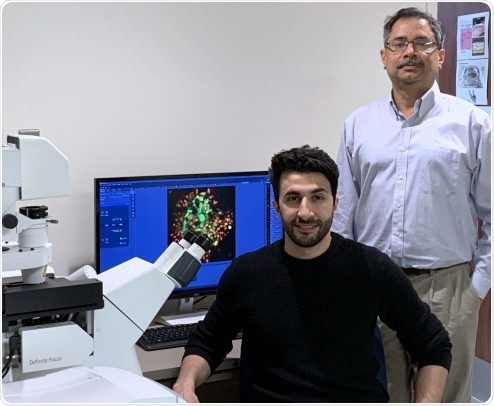Scientists from the University of Illinois Chicago (UIC) have found that heparanase (HPSE)—a poorly understood protein—is an important regulator of innate defense mechanisms of cells.

UIC medical and Ph.D. student Alex Agelid, left, and Dr. Deepak Shukla, UIC Marion Schenk Professor of Ophthalmology and UIC professor of microbiology and immunology at the College of Medicine. Image Credit: University of Illinois Chicago.
Inherent defense responses are essentially programmed cellular mechanisms that are activated by different danger signals preserved in several species all through the evolutionary process.
These mechanisms can be activated by pathogens, like bacteria, parasites, and viruses, and also by dysfunctional cells that can build up in the body over time and by environmental toxins. A better understanding of the connections and similarities between these mechanisms could help develop a multi-target treatment for a wide range of human diseases.
Investigators used a systematic method to monitor the changes in crucial cellular building blocks in cells and also in mice that were genetically modified to lack the HPSE protein. This study was carried out by a multi-institution research team, headed by Alex Agelidis, an MD/Ph.D. dual degree medical student from UCI and Dr. Deepak Shukla, the Marion Schenk Professor of Ophthalmology from UIC. Dr. Shukla is also a UCI professor of microbiology and immunology from the College of Medicine.
In this joint multidisciplinary analysis, Agelidis and the coauthors of the study demonstrated, for the first time, that the HPSE protein functions as a cellular crossroad between proliferative signals, antiviral immunity, and cell death.
HPSE has been long known to drive late-stage inflammatory diseases yet it was once thought that this was primarily due to enzymatic activity of the protein breaking down heparan sulfate, a sugar molecule present in chains on the surface of virtually all cells.”
Alex Agelidis, Dual Degree Medical Student, University of Illinois Chicago
Although the primary goal of this analysis was to identify the pathogenetic mechanisms of herpes simplex virus (HSV-1), the researchers’ study has far-reaching potential for treating various disorders involving HPSE dysregulation, such as atherosclerosis, cancer, and autoimmune disorders.
Source:
Journal reference:
Agelidis, A., et al. (2021) Disruption of innate defense responses by endoglycosidase HPSE promotes cell survival. Journal of Clinical Investigation Insight. doi.org/10.1172/jci.insight.144255.